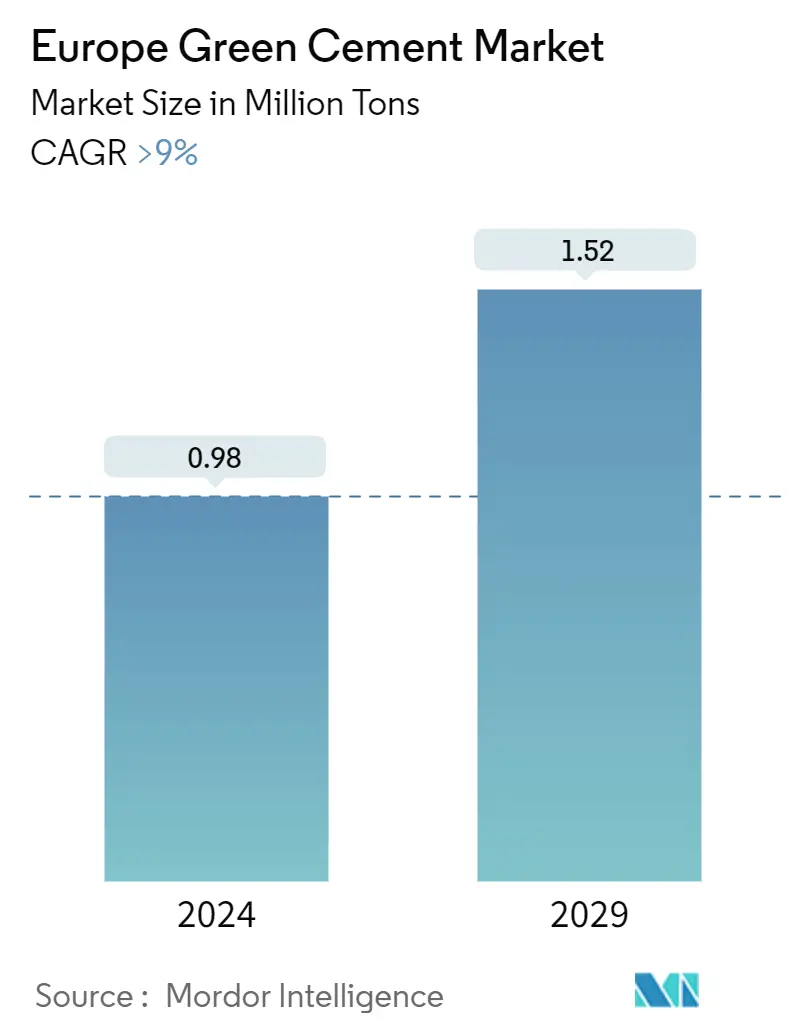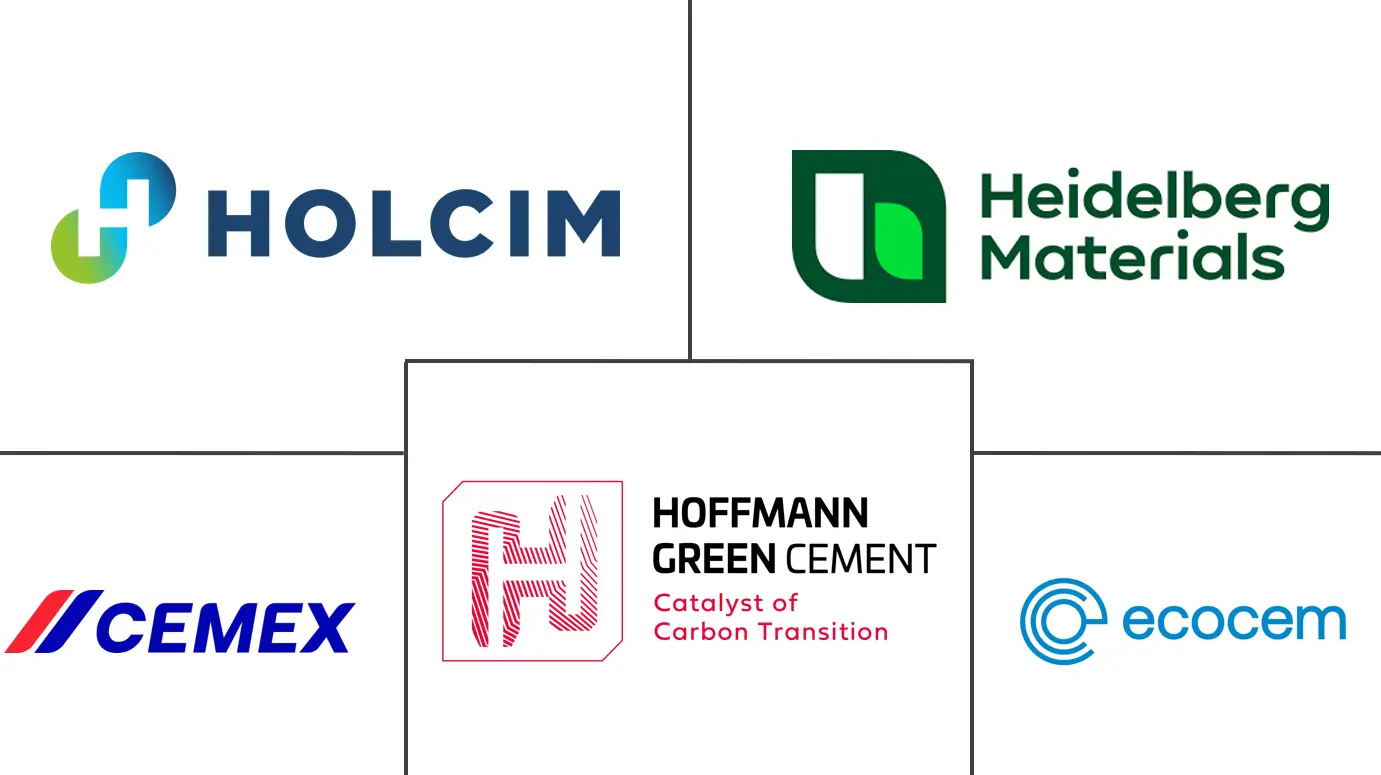Market Size of Europe Green Cement Industry

| Study Period | 2019-2029 |
| Base Year For Estimation | 2023 |
| Market Volume (2024) | 0.98 Million tons |
| Market Volume (2029) | 1.52 Million tons |
| CAGR (2024 - 2029) | > 9.00 % |
| Market Concentration | High |
Major Players
*Disclaimer: Major Players sorted in no particular order |
Europe Green Cement Market Analysis
The Europe Green Cement Market size is estimated at 0.98 Million tons in 2024, and is expected to reach 1.52 Million tons by 2029, growing at a CAGR of greater than 9% during the forecast period (2024-2029).
The COVID-19 pandemic in 2020 affected several industries negatively. The lockdown in most European countries caused construction activities to slow down, leading to reduced demand for green cement in the region. The green cement market's conditions started to recover in 2021 as the vaccination rates were increased and multiple government restrictions were lifted.
Over the short term, growth in sustainable projects in major economies like Germany, France, the United Kingdom, and Italy, favorable government policies for the usage of green cement, and availability of raw materials are major factors driving the growth of the market studied.
However, the rising cost of construction is likely to restrain the growth of the studied market.
Nevertheless, research and development of novel products as raw materials for green cement will likely create lucrative growth opportunities for the global market.
Germany represents the largest market over the forecast period due to the increasing adoption of green cement in its construction projects.
Europe Green Cement Industry Segmentation
Green Cement is an environmentally friendly cement that reduces carbon dioxide emissions during manufacturing. Green cement is mostly produced from raw materials that are discarded as waste from industrial processes. Some of the major raw materials for producing green cement include the slag from the blast furnace and fly ash. Magnesium oxychloride cement, calcium sulfoaluminate cement, geopolymer cement, and sequestrated carbon cement are some examples of green cement.
Europe's green cement market is segmented by product type, construction sector, and geography (Germany, the United Kingdom, Italy, France, Spain, Northern Ireland, Turkey, Russia, and the Rest of Europe). By product type, the market is segmented into fly ash-based, slag-based, limestone-based, silica fume-based, and other product types (geopolymers and recycled aggregates). By the construction sector, the market is segmented into residential and non-residential. The report also covers the market size and forecasts for the European green cement market in 8 countries across the European region.
For each segment, the market sizing and forecasts have been done on the basis of volume (tons).
| Product Type | |
| Fly Ash-based | |
| Slag-based | |
| Limestone-based | |
| Silica fume-based | |
| Other Product Types (Geopolymers and Recycled Aggregates) |
| Construction Sector | |
| Residential | |
| Non-residential |
| Geography | |
| Germany | |
| United Kingdom | |
| France | |
| Spain | |
| Russia | |
| NORDIC | |
| Italy | |
| Turkey | |
| Rest of Europe |
Europe Green Cement Market Size Summary
The European green cement market is poised for significant growth, driven by increasing demand for sustainable construction practices across major economies such as Germany, France, the United Kingdom, and Italy. The market's recovery post-COVID-19 is attributed to the lifting of restrictions and the resurgence of construction activities. Key factors propelling the market include favorable government policies, the availability of raw materials, and a growing emphasis on sustainable projects. However, the rising cost of construction materials poses a challenge to market expansion. Germany is expected to lead the market due to its robust adoption of green cement in construction projects, supported by government initiatives aimed at achieving climate neutrality by 2045.
The European Union's ambitious targets for reducing greenhouse gas emissions and enhancing energy efficiency in buildings are further fueling the demand for green cement. Initiatives such as the renovation wave and the European green building pact underscore the region's commitment to sustainable development. Significant investments are being made to upgrade residential and commercial properties, particularly in Italy and France, to meet these goals. The market is characterized by a partially consolidated landscape, with major players like HOLCIM, Hoffmann Green Cement Technologies, CEMEX, S.A.B. de C.V., Heidelberg Materials, and Ecocem leading the charge in innovation and expansion. These companies are actively pursuing partnerships and technological advancements to enhance their product offerings and reduce carbon footprints, ensuring a strong demand for green cement in the coming years.
Europe Green Cement Market Size - Table of Contents
-
1. MARKET DYNAMICS
-
1.1 Drivers
-
1.1.1 Growth in Sustainable Projects in Europe
-
1.1.2 Favorable Government Policies for Green Building Construction
-
1.1.3 Abundance of Availability of Raw Materials
-
-
1.2 Restraints
-
1.2.1 Rising Construction Costs
-
1.2.2 Other Restraints
-
-
1.3 Industry Value Chain Analysis
-
1.4 Porter's Five Forces Analysis
-
1.4.1 Bargaining Power of Suppliers
-
1.4.2 Bargaining power of Buyers
-
1.4.3 Threat of New Entrants
-
1.4.4 Threat of Substitute Products and Services
-
1.4.5 Degree of Competition
-
-
-
2. MARKET SEGMENTATION (Market Size in Volume)
-
2.1 Product Type
-
2.1.1 Fly Ash-based
-
2.1.2 Slag-based
-
2.1.3 Limestone-based
-
2.1.4 Silica fume-based
-
2.1.5 Other Product Types (Geopolymers and Recycled Aggregates)
-
-
2.2 Construction Sector
-
2.2.1 Residential
-
2.2.2 Non-residential
-
-
2.3 Geography
-
2.3.1 Germany
-
2.3.2 United Kingdom
-
2.3.3 France
-
2.3.4 Spain
-
2.3.5 Russia
-
2.3.6 NORDIC
-
2.3.7 Italy
-
2.3.8 Turkey
-
2.3.9 Rest of Europe
-
-
Europe Green Cement Market Size FAQs
How big is the Europe Green Cement Market?
The Europe Green Cement Market size is expected to reach 0.98 million tons in 2024 and grow at a CAGR of greater than 9% to reach 1.52 million tons by 2029.
What is the current Europe Green Cement Market size?
In 2024, the Europe Green Cement Market size is expected to reach 0.98 million tons.

